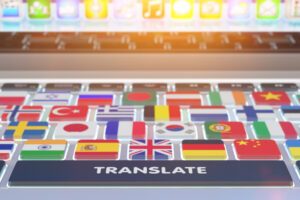Note: This blog post was originally written in Japanese for our Japanese website. We used our machine translation platform Translation Designer to translate it and post-edit the content in English. The original Japanese post can be found here.
There are several thousand translation companies in the translation industry.
If there are that many companies, you're probably wondering how to even choose one when requesting translation for the first time. In this post, we have briefly summarized some ways to choose when looking for a translation agency, ranging from a small request of one-page translation to larger contracts of annual projects.
One-shot request
Get a referral
Your coworkers may already have a history of requesting translation services from a specific translation company.
Some examples of teams/departments that often work with translation companies are public relations and IT/tech such as development, technology design, and information engineering. These teams/departments often outsource translation, so they may have knowledge about the pros and cons of certain translation companies. And if they do, they will also know how to make translation requests, such as what format to provide data and what kind of reference materials are helpful for translation, and what to check after receiving the translated work.
Furthermore, if you can also ask for a specific contact of the translation company (e.g., an account manager that takes your company's requests), you'll be able to make a smooth request. This person may have more information than one of your coworkers, including the approval process and what steps to take to request, from his/her experience working with many projects of your company.
This is why the shortcut is to simply ask if your coworkers know of any good translation companies.
Search on the Internet
When searching for a translation company on the Internet, it is a good idea to find at least three candidates. We recommend that you check and summarize the strengths and characteristics of those companies. Here are some examples of choosing those three candidates.
- 3 candidates with similar strengths (such as they are good at translating manufacturing manuals)
- 3 candidates with strengths in high-quality translation
- 3 candidates with strength in competitive pricing
- 3 candidates that are big names in the translation industry
There are numerous ways to pick out candidates. However, you should be aware of that translation companies do not have to be large in order to provide excellent services. There are many translation agencies that provide excellent services regardless of company size. So, it is important to find the company that you feel is the easiest to work with in terms of quality, turnaround time, cost, etc.

Selecting a contractor for a long-term translation project
When selecting a contractor for a long-term translation project, it is necessary to consider the selection method in a somewhat planned manner. This is because it is difficult to discern a vendor's essential strengths and operational flexibility through numerical superiority or a one-off test translation.
Gather information
First of all, it is important to clarify the background and purpose of why this vendor selection is being done. If you already have an established outsourcing translation process, you can provide a description and issues of that process. The issues should show what you want the translation company to accomplish for you.
Or, if you are adopting a new translation process, you can briefly summarize and share the requirements.
Request for proposal
One way to approach it is to put the compiled information in a form of a Request for Proposal (RFP). In addition, with the mentioned information, it is efficient to determine the scale of the project, selection priority, and expected time frame. It's also a good idea to attach a questionnaire about specific aspects of your project (for example, what tools you use and how you handle security issues).
Regarding recent trends, we recommend that you also include a question to ask their experience in machine translation and post-editing services. This is because, over a period of several years, it is conceivable that part of the translation work will be replaced by some kind of machine translation even if it's not incorporated now.

Compile this information into an RFP and request several potential translation vendors to submit a proposal.
Set up a meeting
As explained above, it is difficult to tell whether a translation company is really good just by looking at the numbers and specifications on the surface. Therefore, it's a good idea to include meetings in the selection process.
After all, it is humans who interact with each other. If possible, we recommend that along with the contact person (in most cases, an account manager), have the project manager, who will actually be leading the project, join the meeting.
Summary
In this post, we briefly summarized some ways to choose when looking for a translation agency. In any case and regardless of the project size, it's important to clearly indicate what the priority is for you and what you expect when selecting a translation agency.
Kawamura's translation services
Kawamura International offers translation services in fields such as IT, medical devices, legal, finance, and patent, supporting more than 40 languages.
We provide consulting on the effective use of machine translation with post-editing services along with human translation services to meet the various needs of our customers. Not only that we also handle a variety of language-related services, such as editing and localization services of video and audio data.
Get in touch with us if you need professional translation services or have any other questions about translation and localization services in general.
_CMYK_OL.png)

